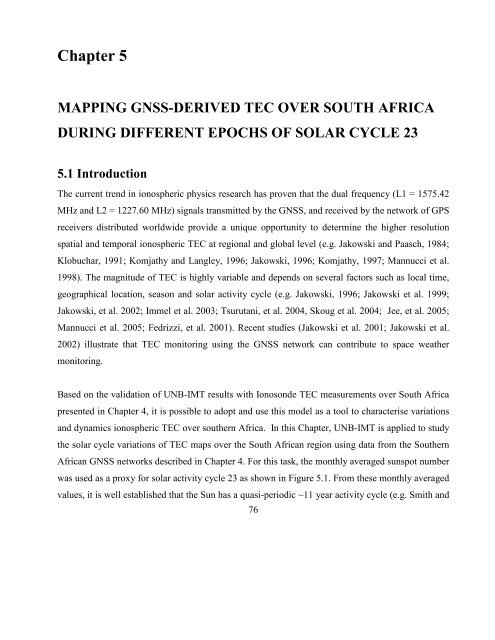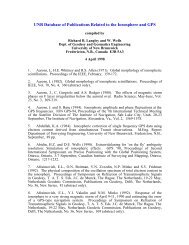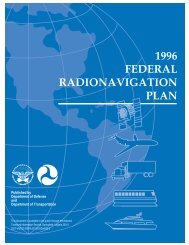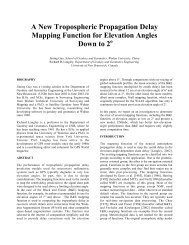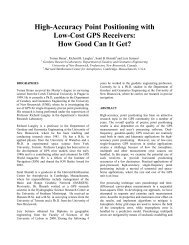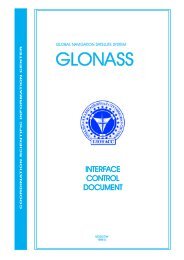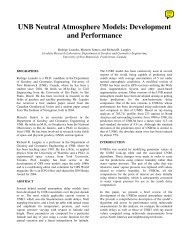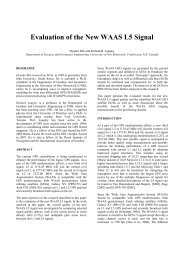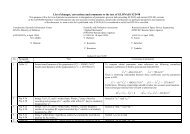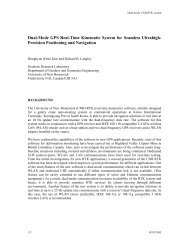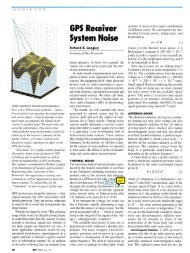solar cycle effects on gnss-derived ionospheric total electron content ...
solar cycle effects on gnss-derived ionospheric total electron content ...
solar cycle effects on gnss-derived ionospheric total electron content ...
Create successful ePaper yourself
Turn your PDF publications into a flip-book with our unique Google optimized e-Paper software.
Chapter 5MAPPING GNSS-DERIVED TEC OVER SOUTH AFRICADURING DIFFERENT EPOCHS OF SOLAR CYCLE 235.1 Introducti<strong>on</strong>The current trend in i<strong>on</strong>ospheric physics research has proven that the dual frequency (L1 = 1575.42MHz and L2 = 1227.60 MHz) signals transmitted by the GNSS, and received by the network of GPSreceivers distributed worldwide provide a unique opportunity to determine the higher resoluti<strong>on</strong>spatial and temporal i<strong>on</strong>ospheric TEC at regi<strong>on</strong>al and global level (e.g. Jakowski and Paasch, 1984;Klobuchar, 1991; Komjathy and Langley, 1996; Jakowski, 1996; Komjathy, 1997; Mannucci et al.1998). The magnitude of TEC is highly variable and depends <strong>on</strong> several factors such as local time,geographical locati<strong>on</strong>, seas<strong>on</strong> and <str<strong>on</strong>g>solar</str<strong>on</strong>g> activity <str<strong>on</strong>g>cycle</str<strong>on</strong>g> (e.g. Jakowski, 1996; Jakowski et al. 1999;Jakowski, et al. 2002; Immel et al. 2003; Tsurutani, et al. 2004, Skoug et al. 2004; Jee, et al. 2005;Mannucci et al. 2005; Fedrizzi, et al. 2001). Recent studies (Jakowski et al. 2001; Jakowski et al.2002) illustrate that TEC m<strong>on</strong>itoring using the GNSS network can c<strong>on</strong>tribute to space weatherm<strong>on</strong>itoring.Based <strong>on</strong> the validati<strong>on</strong> of UNB-IMT results with I<strong>on</strong>os<strong>on</strong>de TEC measurements over South Africapresented in Chapter 4, it is possible to adopt and use this model as a tool to characterise variati<strong>on</strong>sand dynamics i<strong>on</strong>ospheric TEC over southern Africa. In this Chapter, UNB-IMT is applied to studythe <str<strong>on</strong>g>solar</str<strong>on</strong>g> <str<strong>on</strong>g>cycle</str<strong>on</strong>g> variati<strong>on</strong>s of TEC maps over the South African regi<strong>on</strong> using data from the SouthernAfrican GNSS networks described in Chapter 4. For this task, the m<strong>on</strong>thly averaged sunspot numberwas used as a proxy for <str<strong>on</strong>g>solar</str<strong>on</strong>g> activity <str<strong>on</strong>g>cycle</str<strong>on</strong>g> 23 as shown in Figure 5.1. From these m<strong>on</strong>thly averagedvalues, it is well established that the Sun has a quasi-periodic ~11 year activity <str<strong>on</strong>g>cycle</str<strong>on</strong>g> (e.g. Smith and76


